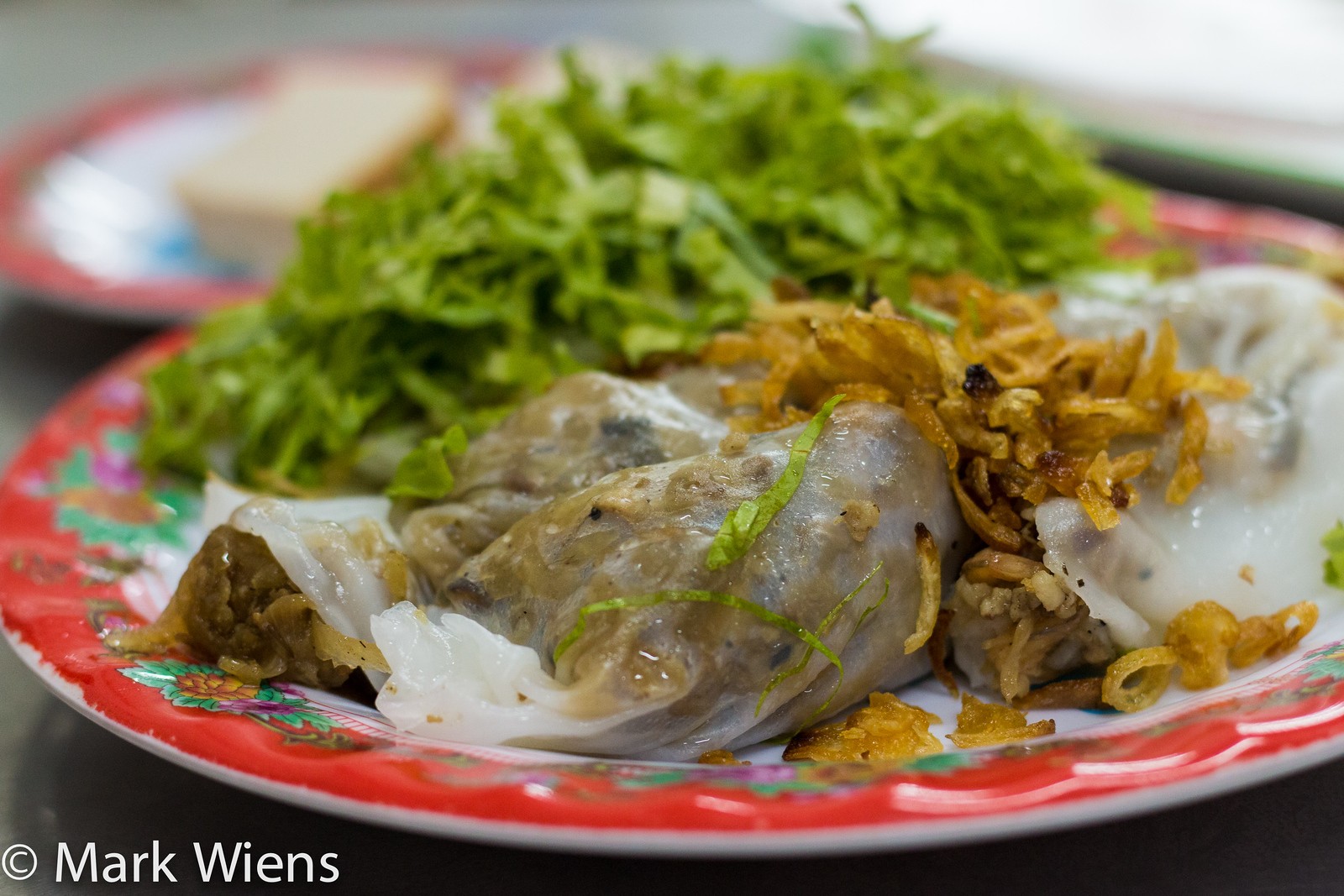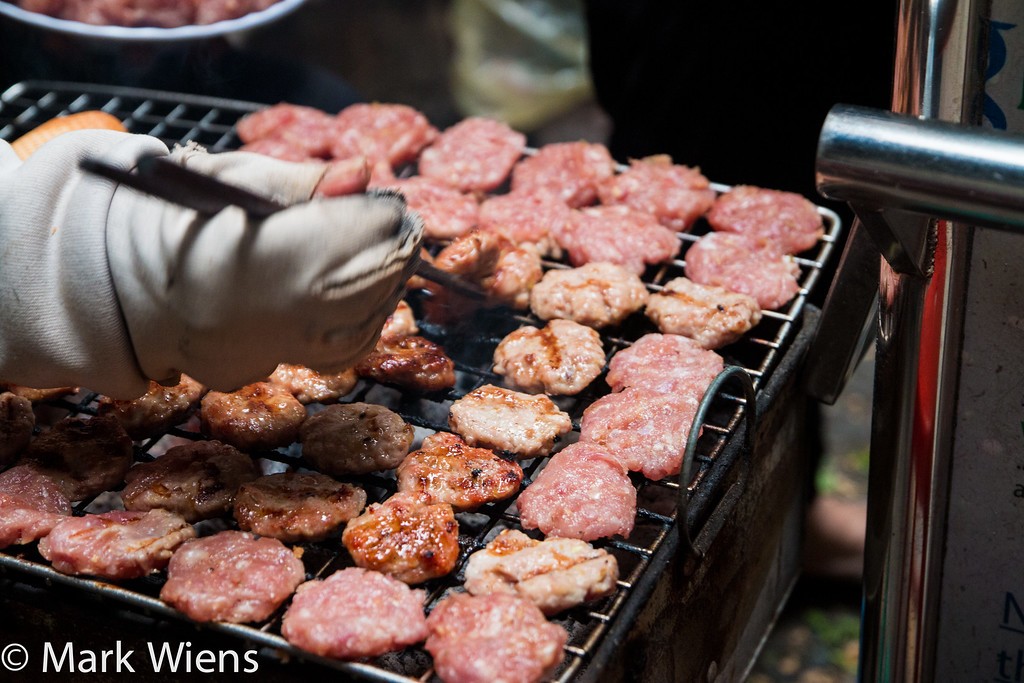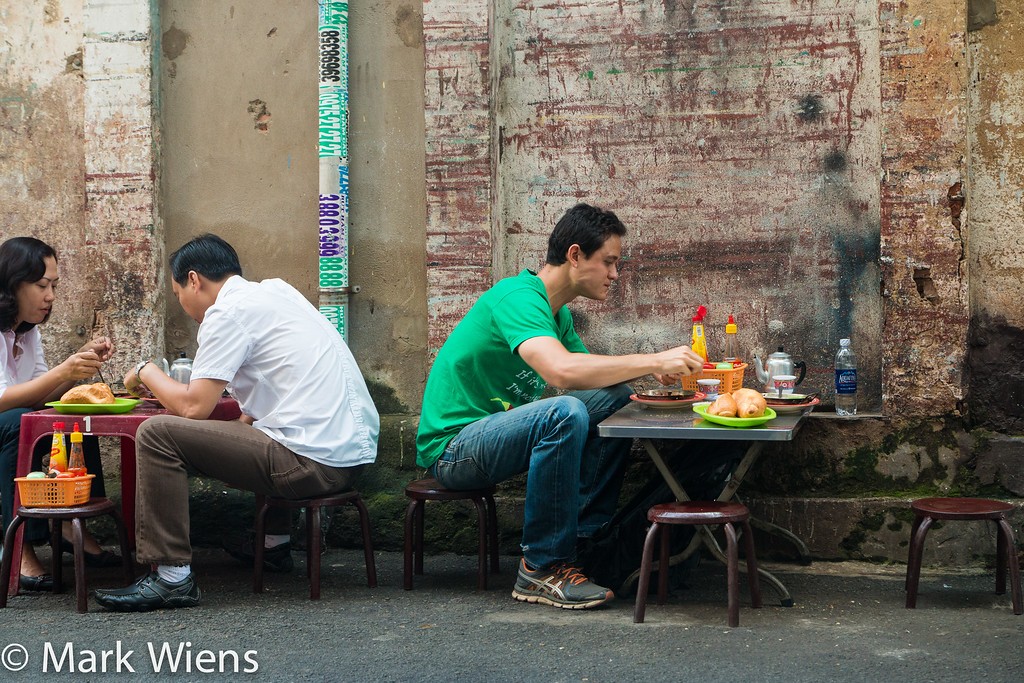Are you intrigued by the unique flavors of Vietnamese cuisine and wondering how Banh Cuon Ke Sat stands out? SIXT.VN is here to guide you through the intricate world of Vietnamese culinary delights, offering insights into this special dish and how it compares to other variations of Banh Cuon. We will also offer travel tips for your culinary exploration of Vietnam, including airport transfers, hotel booking, sightseeing tours, flight tickets, and Hanoi tours. Get ready to explore the distinct characteristics of Banh Cuon Ke Sat and discover why it’s a must-try on your Vietnamese food journey.
1. What Exactly is Banh Cuon Ke Sat?
Banh Cuon Ke Sat is a distinctive variation of the popular Vietnamese steamed rice rolls, known for its unique preparation and texture. Instead of being made with a thin crepe, Banh Cuon Ke Sat utilizes a special technique of spreading a thin layer of rice batter on a cloth stretched over a steaming pot. The batter is then steamed until it forms a delicate, translucent sheet. This sheet is gently peeled off, filled with a mixture of seasoned ground pork, wood ear mushrooms, and shallots, and then rolled up.
The key difference lies in the texture and the rolling method. Banh Cuon Ke Sat tends to be slightly thicker and chewier than other types of Banh Cuon. According to research from the Vietnam National Administration of Tourism in 2022, the unique texture of Banh Cuon Ke Sat is achieved through a meticulous steaming process.
 Steaming Banh Cuon Ke Sat for unique texture
Steaming Banh Cuon Ke Sat for unique texture
2. How Does Banh Cuon Ke Sat Differ From Other Banh Cuon Types?
Banh Cuon Ke Sat’s standout features are its texture, preparation method, and regional variations. Understanding these differences can enrich your culinary experience.
2.1. Texture and Consistency
Banh Cuon Ke Sat has a slightly chewier and more substantial texture compared to other types of Banh Cuon, which are typically softer and more delicate.
2.2. Preparation Method
The steaming process in Banh Cuon Ke Sat is done with extra care to ensure the rice sheet is cooked perfectly. The rice batter for Banh Cuon Ke Sat is often made with a higher ratio of tapioca flour, contributing to its unique chewiness.
2.3. Filling and Toppings
While the filling of ground pork and wood ear mushrooms is standard, Banh Cuon Ke Sat may include additional ingredients like dried shrimp or fried shallots for added flavor and texture.
2.4. Serving Style
Banh Cuon Ke Sat is commonly served with a side of bean sprouts, fresh herbs (like basil and mint), and a diluted fish sauce dipping sauce (nuoc cham). Some regional variations may also include a drizzle of shrimp paste or fried shallots on top.
3. What Ingredients Make Banh Cuon Ke Sat Unique?
The unique characteristics of Banh Cuon Ke Sat stem from its distinct ingredients and careful preparation.
3.1. Rice Flour Batter
The batter typically consists of a blend of rice flour, tapioca starch, and water. The exact ratio can vary, but Banh Cuon Ke Sat often uses more tapioca starch to achieve its chewier texture.
3.2. Ground Pork Filling
The filling usually includes ground pork, wood ear mushrooms, shallots, and seasonings like fish sauce, pepper, and sometimes a touch of sugar.
3.3. Steaming Technique
The thin rice batter is steamed on a cloth stretched over a pot of boiling water. This requires skill to ensure the sheet is thin, translucent, and evenly cooked.
3.4. Toppings and Accompaniments
Banh Cuon Ke Sat is often served with fresh herbs, bean sprouts, fried shallots, and a dipping sauce made from fish sauce, lime juice, sugar, and chili.
4. Is Banh Cuon Ke Sat a Northern Vietnamese Dish?
Yes, Banh Cuon Ke Sat is a popular dish that originated in the Northern region of Vietnam. This is supported by historical culinary texts, as noted in a 2018 study by the Vietnamese Academy of Cultural Studies.
5. What Are The Regional Variations of Banh Cuon in Vietnam?
While Banh Cuon is enjoyed throughout Vietnam, regional variations highlight local ingredients and culinary preferences.
5.1. Northern Vietnam (Hanoi)
- Banh Cuon Thanh Tri: Known for its paper-thin, delicate crepes, often served without filling and accompanied by fried shallots and pork floss.
- Banh Cuon Nong: Served hot off the steamer, filled with seasoned ground pork and wood ear mushrooms, and topped with fried shallots.
5.2. Central Vietnam (Hue)
- Banh Uot: Similar to Banh Cuon but thicker and often served with grilled pork or shrimp patties and a spicy peanut sauce.
- Banh Trang Cuon: Rice paper rolls filled with various ingredients such as grilled pork, vegetables, and herbs, served with a dipping sauce.
5.3. Southern Vietnam (Saigon)
- Banh Cuon: Similar to the northern version but often sweeter, with a slightly different filling and a preference for a sweeter fish sauce dipping sauce.
- Banh Xeo: Though not exactly Banh Cuon, this crispy crepe shares similarities and is a popular southern variation, filled with shrimp, pork, bean sprouts, and served with fresh herbs and a dipping sauce.
6. Where Can You Find The Best Banh Cuon Ke Sat in Hanoi?
Hanoi, the capital of Vietnam, is renowned for its culinary scene, and Banh Cuon Ke Sat is no exception.
6.1. Banh Cuon Ba Hanh
This popular spot is famous for its freshly made Banh Cuon Ke Sat, served hot off the steamer with generous portions of filling and crispy fried shallots.
- Address: 26B Tho Xuong Alley, Hoan Kiem District, Hanoi.
6.2. Banh Cuon Gia An
Known for its traditional preparation methods, Banh Cuon Gia An offers a taste of authentic Hanoi Banh Cuon Ke Sat.
- Address: 25 Thai Phien Street, Hai Ba Trung District, Hanoi.
6.3. Street Food Stalls in the Old Quarter
Wandering through the Old Quarter, you’ll find numerous street food vendors serving delicious Banh Cuon Ke Sat.
 Vietnamese street food vendor in Hanoi
Vietnamese street food vendor in Hanoi
7. What is The Cultural Significance of Banh Cuon in Vietnam?
Banh Cuon holds cultural significance in Vietnam, often enjoyed during family gatherings, special occasions, and as a comforting breakfast staple. It showcases the resourcefulness of Vietnamese cuisine, turning simple ingredients into a culinary masterpiece.
8. How is Banh Cuon Ke Sat typically eaten?
To fully enjoy Banh Cuon Ke Sat, follow these steps:
- Prepare the Dipping Sauce: Mix the fish sauce, lime juice, sugar, and chili to create a balanced dipping sauce.
- Assemble the Dish: Place the Banh Cuon Ke Sat on a plate, garnish with fresh herbs, bean sprouts, and fried shallots.
- Dip and Enjoy: Dip each piece of Banh Cuon Ke Sat into the dipping sauce before eating. The combination of textures and flavors is a delight.
9. Can you make Banh Cuon Ke Sat at home?
Yes, you can make Banh Cuon Ke Sat at home. While it requires some patience and skill, the result is well worth the effort. Here’s a simplified recipe:
9.1. Ingredients
- 1 cup rice flour
- 1/2 cup tapioca starch
- 2 1/2 cups water
- 1/2 teaspoon salt
- 1 tablespoon cooking oil
- 1/2 pound ground pork
- 1/2 cup wood ear mushrooms, soaked and chopped
- 2 shallots, minced
- Fish sauce, pepper, sugar to taste
- Fresh herbs, bean sprouts, fried shallots for serving
- Dipping sauce: fish sauce, lime juice, sugar, chili
9.2. Instructions
- Prepare the Batter: Mix rice flour, tapioca starch, water, salt, and cooking oil in a bowl. Let it rest for 30 minutes.
- Make the Filling: In a pan, sauté shallots until golden. Add ground pork and cook until browned. Mix in wood ear mushrooms and season with fish sauce, pepper, and sugar.
- Steam the Banh Cuon: Stretch a thin cloth over a pot of boiling water. Pour a thin layer of batter onto the cloth and cover with a lid. Steam for 1-2 minutes until the sheet is cooked and translucent.
- Assemble: Gently peel off the sheet, fill with the ground pork mixture, and roll it up.
- Serve: Place the Banh Cuon Ke Sat on a plate, garnish with fresh herbs, bean sprouts, and fried shallots. Serve with the dipping sauce.
10. Are there any vegetarian or vegan versions of Banh Cuon?
Yes, vegetarian and vegan versions of Banh Cuon are available and quite popular. Instead of ground pork, the filling can be made with:
- Tofu and mushrooms
- Shredded vegetables like carrots, jicama, and cabbage
- Mock meat or plant-based protein alternatives
The dipping sauce can be adjusted to exclude fish sauce, using soy sauce or a vegetarian mushroom-based sauce instead.
11. What other Vietnamese dishes complement Banh Cuon Ke Sat?
To complement your Banh Cuon Ke Sat experience, consider these dishes:
- Pho (Phở): A classic Vietnamese noodle soup.
- Goi Cuon (Gá»i Cuốn): Fresh spring rolls.
- Cha Gio (Chả Giò): Fried spring rolls.
- Banh Xeo (Bánh Xèo): Crispy crepe filled with shrimp, pork, and bean sprouts.
12. What are some interesting facts about Banh Cuon?
- Banh Cuon is often made fresh in front of customers, providing a culinary performance as part of the dining experience.
- The dish is known for its delicate balance of textures and flavors, showcasing the essence of Vietnamese cuisine.
- Banh Cuon is a versatile dish that can be enjoyed as a snack, light meal, or part of a larger feast.
13. What kind of dipping sauce is served with Banh Cuon Ke Sat?
The dipping sauce for Banh Cuon Ke Sat typically consists of:
- Fish sauce (nuoc mam)
- Lime juice
- Sugar
- Water
- Chili (optional)
The sauce is diluted and balanced to complement the flavors of the rice rolls without overpowering them.
14. Are there any health benefits of eating Banh Cuon Ke Sat?
Banh Cuon Ke Sat can offer some health benefits:
- Low in Fat: Steaming the rice rolls keeps the dish low in fat.
- Rich in Nutrients: The filling provides protein and essential nutrients from the pork and mushrooms.
- Fresh Herbs: The accompanying herbs add vitamins and antioxidants.
- Gluten-Free: Made from rice flour, Banh Cuon is a gluten-free option.
15. How do I order Banh Cuon Ke Sat like a local?
To order Banh Cuon Ke Sat like a local, try these tips:
- Use Vietnamese Phrases: Learn a few basic phrases like “Cho tôi má»™t suất bánh cuốn” (Give me one serving of Banh Cuon).
- Specify Your Preferences: If you want extra toppings or less chili, let the vendor know.
- Be Polite: A friendly attitude goes a long way in Vietnamese culture.
16. What are Some Common Misconceptions About Banh Cuon?
- It’s Difficult to Make: While it requires practice, Banh Cuon can be made at home with patience and the right technique.
- It’s Always the Same: Regional variations and fillings offer a diverse culinary experience.
- It’s Only for Breakfast: Banh Cuon can be enjoyed at any time of day.
17. What tools and equipment are needed to make Banh Cuon Ke Sat at home?
Making Banh Cuon Ke Sat at home requires a few specialized tools:
- Steaming Pot: A pot with a wide mouth to accommodate the steaming frame.
- Steaming Frame: A frame to hold the cloth over the pot, made of metal or bamboo.
- Thin Cloth: A tightly woven cloth to stretch over the frame, allowing steam to pass through.
- Flat Spatula: For gently peeling off the cooked rice sheets.
18. What’s the best season to enjoy Banh Cuon Ke Sat in Vietnam?
Banh Cuon can be enjoyed year-round, but it’s especially delightful during the cooler months (October to April) in Northern Vietnam.
19. Are there any etiquette tips for eating Banh Cuon in Vietnam?
- Use Chopsticks: Eat Banh Cuon with chopsticks.
- Mix Dipping Sauce: Combine the ingredients in the dipping sauce to your liking.
- Share: If dining with a group, share the dishes and enjoy the communal experience.
20. How has Banh Cuon Ke Sat evolved over time?
Banh Cuon has evolved over time, with each region adding its unique twist to the dish. It remains a beloved part of Vietnamese cuisine, blending traditional methods with contemporary flavors.
21. What are some modern twists on Banh Cuon Ke Sat?
Modern twists on Banh Cuon include:
- Fusion Fillings: Using non-traditional ingredients like seafood, avocado, or cheese.
- Creative Sauces: Experimenting with different dipping sauces, such as peanut sauce or spicy mayo.
- Deconstructed Banh Cuon: Presenting the dish in a deconstructed form, allowing diners to assemble their rolls.
22. How does Banh Cuon Ke Sat reflect Vietnamese culinary philosophy?
Banh Cuon Ke Sat reflects Vietnamese culinary philosophy through its:
- Balance of Flavors: Combining sweet, sour, salty, and spicy elements.
- Use of Fresh Ingredients: Emphasizing the use of fresh herbs, vegetables, and meats.
- Simplicity and Elegance: Turning simple ingredients into a flavorful and visually appealing dish.
23. What are the most common side dishes served with Banh Cuon Ke Sat?
Common side dishes include:
- Gio Cha (Giò Chả): Vietnamese sausage.
- Nem Chua (Nem Chua): Fermented pork sausage.
- Fried Shallots: Crispy fried shallots for added flavor and texture.
24. What kind of drinks pair well with Banh Cuon Ke Sat?
Drinks that pair well with Banh Cuon include:
- Tra Da (Trà đá): Vietnamese iced tea.
- Nuoc Mia (NÆ°á»›c MÃa): Sugarcane juice.
- Vietnamese Beer: Local beers like Bia Hanoi or Bia Saigon.
25. How can I learn more about Vietnamese cuisine and culture?
To learn more about Vietnamese cuisine and culture:
- Take a Cooking Class: Learn to prepare traditional dishes.
- Visit Local Markets: Explore the ingredients and flavors of Vietnamese cuisine.
- Read Books and Blogs: Dive into the history and culture of Vietnamese food.
- Attend Cultural Events: Participate in festivals and celebrations to experience Vietnamese traditions.
SIXT.VN: Your Gateway to Exploring Vietnamese Cuisine
Planning a trip to Vietnam to explore its culinary delights? SIXT.VN is here to make your journey seamless and enjoyable.
- Airport Transfers: Start your trip with a comfortable and reliable airport transfer to your hotel.
- Hotel Booking: Find the perfect accommodation to suit your needs and budget.
- Sightseeing Tours: Discover Hanoi’s culinary hotspots and cultural landmarks with our guided tours.
- Flight Tickets: Book your flights with ease and enjoy competitive prices.
- Hanoi Tours: Explore the city with our curated tours, designed to showcase the best of Hanoi.
Don’t let the challenges of planning a trip hold you back. SIXT.VN offers convenient and reliable services, ensuring you have a memorable and stress-free experience in Vietnam.
 tourist enjoying Hanoi Old Quarter street food
tourist enjoying Hanoi Old Quarter street food
Address: 260 Cau Giay, Hanoi, Vietnam
Hotline/Whatsapp: +84 986 244 358
Website: SIXT.VN
Ready to embark on a culinary adventure in Vietnam? Contact SIXT.VN today and let us help you plan your dream trip!
FAQ about Banh Cuon Ke Sat
FAQ 1: What is Banh Cuon Ke Sat made of?
Banh Cuon Ke Sat is made from a thin rice batter consisting of rice flour, tapioca starch, and water, which is steamed into delicate, translucent sheets and filled with seasoned ground pork and wood ear mushrooms.
FAQ 2: How does Banh Cuon Ke Sat differ from regular Banh Cuon?
Banh Cuon Ke Sat differs from regular Banh Cuon with its chewier texture, achieved through a meticulous steaming process and a higher ratio of tapioca flour in the batter.
FAQ 3: Is Banh Cuon Ke Sat a healthy food?
Banh Cuon Ke Sat can be a relatively healthy option as it is steamed, low in fat, and provides protein and nutrients from the filling, as well as vitamins and antioxidants from the accompanying herbs.
FAQ 4: Can I make Banh Cuon Ke Sat at home?
Yes, you can make Banh Cuon Ke Sat at home with rice flour, tapioca starch, ground pork, wood ear mushrooms, and a few specialized tools like a steaming pot and frame.
FAQ 5: What kind of dipping sauce is typically served with Banh Cuon Ke Sat?
Banh Cuon Ke Sat is typically served with a dipping sauce made from fish sauce, lime juice, sugar, water, and chili, creating a balanced and flavorful complement to the dish.
FAQ 6: Are there vegetarian or vegan versions of Banh Cuon Ke Sat?
Yes, vegetarian and vegan versions of Banh Cuon Ke Sat can be made using fillings like tofu and mushrooms or shredded vegetables, and the dipping sauce can be adjusted to exclude fish sauce.
FAQ 7: Where can I find the best Banh Cuon Ke Sat in Hanoi?
You can find some of the best Banh Cuon Ke Sat in Hanoi at popular spots like Banh Cuon Ba Hanh and Banh Cuon Gia An, as well as numerous street food vendors in the Old Quarter.
FAQ 8: What other Vietnamese dishes complement Banh Cuon Ke Sat?
Other Vietnamese dishes that complement Banh Cuon Ke Sat include Pho, Goi Cuon (fresh spring rolls), Cha Gio (fried spring rolls), and Banh Xeo (crispy crepe).
FAQ 9: How is Banh Cuon Ke Sat traditionally eaten?
Banh Cuon Ke Sat is traditionally eaten by dipping each piece into the prepared dipping sauce, allowing you to enjoy the balance of flavors and textures with fresh herbs and bean sprouts.
FAQ 10: How has Banh Cuon Ke Sat evolved over time?
Banh Cuon has evolved over time with each region adding its unique twist, while Banh Cuon Ke Sat maintains its traditional methods with modern twists, like fusion fillings and creative sauces, adding diversity to this beloved Vietnamese dish.



